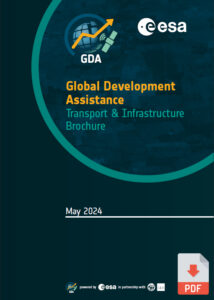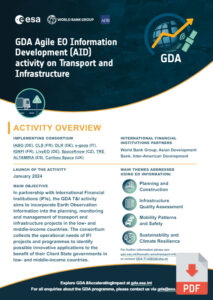Thematic Overview
Globally interconnected economies, increasing urbanisation, population growth, technological progress, and climate change are impacting transportation & logistics, and require new or adapted solutions to tackle these challenges. This includes, among other, assessing the financial impact on the sector. Disaster events and supra-national crisis may affect key infrastructure, flooding causes impassability of transport systems, regulatory requirements demand the reduction of CO2 emissions, and quality of life is significantly impacted by traffic induced air pollution and lack of road safety. Resilient and sustainable transportation networks and infrastructure systems are a mandatory prerequisite for ensuring mobility, access to markets and supply of goods, thus contributing to global connectivity and a prosperous economy. Bringing latest Earth Observation (EO) technology or products into the processes and workflows of relevant IFIs and stakeholder groups will support mainstreaming of EO derived information and level up their capabilities with novel, value adding and independent EO data & analytics.
Transport & Infrastructure Themes
- Monitor infrastructure construction. Infrastructure investments can be located in remote areas or can span large areas which result in high cost, related to field visits for the monitoring of construction. The use of Earth Observation is investigated to remotely monitor the construction and advancement of the infrastructure.
- Assessing transportation infrastructure quality. Analysing the structural integrity, quality and/or degradation of road, port and/or railroad infrastructure to prioritise investments and prevent further damage or safety risks.
- Developing inventories of existing transportation infrastructure. Inventories of existing transportation networks to identify existing resources (e.g., the creation of up-to-date base map of the rural road network). Where updated inventories of a country’s transport infrastructure are not maintained, EO helps to detect existing infrastructure and complete national or regional infrastructure inventories.
- Assessing infrastructure vulnerability to climate risk. The increasing impacts of climate change forces infrastructure investments to factor in any potential acute or chronic climate risk that might impact the infrastructure. Combining EO data, weather data and climate models to analyse past climate events or assess future risks caused by natural hazards is essential to inform risk management and mitigation measures at scale.
- Assessing mobility patterns. As most transportation infrastructure investments build on network analyses and the analysis of mobility patterns, integrating EO data could provide additional mobility datasets and identify peak time periods of activity, modes of transportation, the presence of any physical barriers affecting the routes, movement between specific zones, and any patterns based on the origins and destinations.
- Map road safety hazards. Ensuring road safety is a priority when it comes to road infrastructure investments. Using Earth Observation analysing e.g. topography, land use and height of tree canopy allows to better inform the preparation of road safety projects and their implementation.
- Characterizing transport infrastructure demand. Analysing quality of existing infrastructure as well as potential infrastructure demand is key to the prioritisation of areas for network transport expansion and also to inform asset management systems. Analysing the characteristics of certain regions helps to inform potential demand for infrastructure.
- Environmental impact of planned infrastructure, incl. estimation of emissions levels. Environmental and Social Impact Assessments are a key step in the planning stage of an investment and aim at assessing social and environmental risks as well as building risk mitigation measures into project design. Analysing the concentration and emissions of transport-related pollutants allows to support investments aimed at reducing greenhouse gas emissions and promote sustainable mobility.
Discover our
e-flyer and
brochure for more information regarding services and products provided on these themes in response to requirements identified in the Transport and Infrastructure domain by IFIs and their Client Countries:


Consortium Members

























